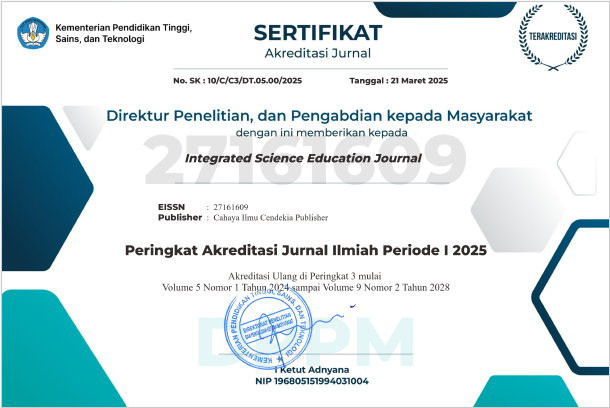| Accreditation |

*) Integrated Science Education Journal is Accredited Sinta 3 by the Director General of Higher Education, Research, and Technology, No. 10/C/C3/DT.05.00/2025 | Vol. 5, No. 1 2023 - Vol.9, No. 2, 2028
| Publisher |
| In Partnership |
| Journal Imprint |
| ISSN |
| People |
| Editorial Team |
| Reviewer |
| Review for This Journal |
| Contact |
| Policies |
| Focus and Scope |
| Peer Review Process |
| Ethics and Malpractice Statement |
| Publication Frequency |
| Open Access Policy |
| Repository Policy |
| Screening for Plagiarism |
| Correction and Retraction |
| Copyright and Licensed |
| Indexing and Abstracting |
| Allegations of Misconduct |
| Generative AI Policy |
| Crossmark Policy |
| Archiving Policy |
| Direct Marketing |
| Advertising |
| Revenue Source |
| Submission |
| Author Guidelines |
| Online Submission |
| Privacy Statement |
| Article Publication Charge |
| Manuscript Template |
| Recommended Tools |
| Journal Metrics |
| Acceptance Rate : | 39% |
| Review Speed : | 30 days |
| Issue Per Year : | 3 |
| Number of Volumes : | 6 |
| Number of Issues : | 13 |
| Number of Articles : | 125 |
| No. of Google Citations : | 988 |
| Google h-index : | 16 |
| Google i10-index : | 35 |
| Abstract Views : | 35.189 |
| PDF Download : | 30.014 |
UPDATE: 26 November 2025
| Visitor |


.png)
.png)






